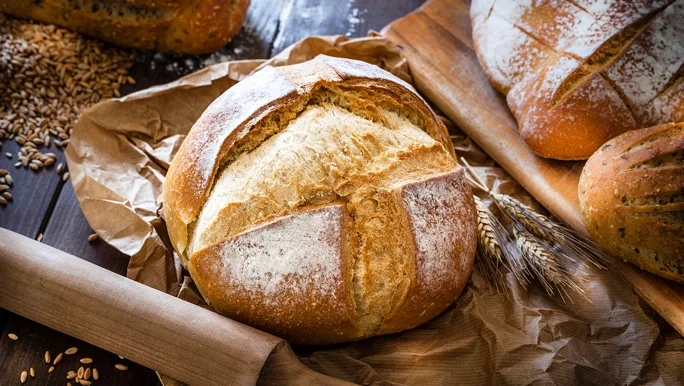The topic of sourdough and FODMAPs can be very confusing. Some sources will say sourdough is suitable on a low FODMAP diet, while others will disagree. Before I clarify the sourdough-FODMAP debate, let’s first take a look at what makes regular bread high FODMAP.
What makes regular bread high FODMAP?
Regular bread typically uses either wheat flour or rye flour, and is therefore high in the FODMAP fructans. The reason gluten-free alternatives are recommended for a low FODMAP diet is that they don’t contain wheat. But… sourdough bread still contains wheat, so does that mean all sourdough is high FODMAP? In short, no. Now let us take a look at why!
Why is some sourdough lower FODMAP than others?
Traditional sourdough bread undergoes a different baking method to regular bread. Sourdough traditionally requires a much longer fermentation process than regular bread. Fermentation is the step in bread making where yeast and bacteria convert carbohydrates to carbon dioxide (gas), which leavens the bread. This is what gives bread its soft, fluffy texture we all love.
Because traditional sourdough undergoes fermentation over several days, the yeast and bacteria (lactobacilli) remove much of the fructans. So generally, the longer the leavening process, the lower the FODMAP content of the sourdough. Now for the slightly confusing part… only some sourdough breads are low FODMAP.
So which sourdough breads are low FODMAP?
Usually, to class as low FODMAP, the sourdough must be “traditional”. Traditional sourdough is fermented for several days, then leavened for at least 24 hours. It contains only water, flour and salt, with no additives.
Some sourdough uses high FODMAP flours such as wheat flour and rye flour. So if the sourdough is made from wheat/rye flour and/or has not undergone traditional sourdough processing, it is most likely high FODMAP. If the dough is made from wheat/rye flour but is a traditional sourdough, one serving (1-2 pieces) should still be low FODMAP.
How can I tell what varieties are ‘traditional’ sourdough?
If purchasing from a bakery ask staff whether their sourdough uses traditional techniques (such as overnight leavening), and what sort of flour they use. If they make their sourdough using traditional techniques, and/or use oat/spelt flour then it should be OK.
When purchasing from a supermarket, start by reading the ingredients list. Since traditional sourdough only uses water, flour, and salt, then minimal (if any) other ingredients should appear. If yeast appears in the ingredients list, it may be high FODMAP. This is because the addition of yeast speeds up the fermentation process so consequently, fructans remain high. Other ingredients to look out for include wheat and high FODMAP sweeteners, such as fructose. If the sourdough ingredients seem fine, ring the bread manufacturer to ask if they apply traditional sourdough techniques during processing.
Key considerations when picking a low FODMAP sourdough:
- Uses traditional sourdough techniques
- Uses oat/spelt flour
- Minimal ingredients (traditionally should only be water, flour and salt). Look out for additives such as yeast and sweeteners.
- More likely to find traditional sourdough in a bakery, rather than a supermarket. Check with your baker regarding what flour and techniques they use.
Need help with the low FODMAP diet? Our FREE dietitian developed program will guide you through it, step-by-step. Includes a low FODMAP food guide. Sign up now.
If you are experiencing gut symptoms and have not been recommended a low FODMAP diet by a health professional, get started with the manage your gut symptoms program.
Reviewed by the healthylife Advisory Board March 2022
